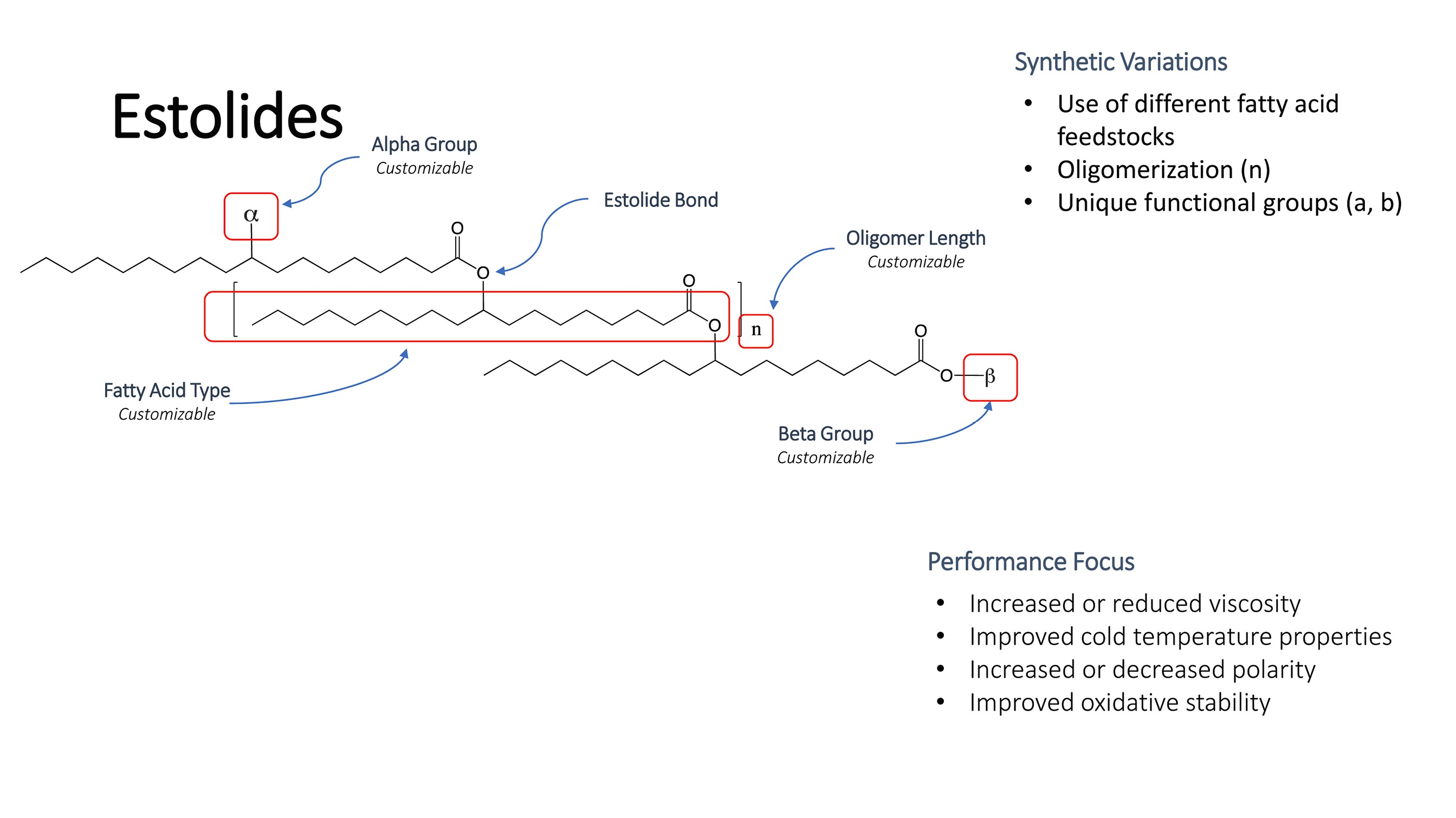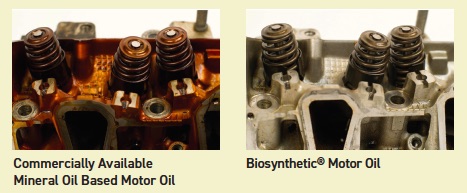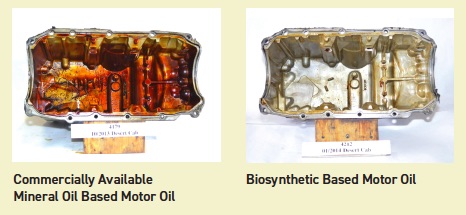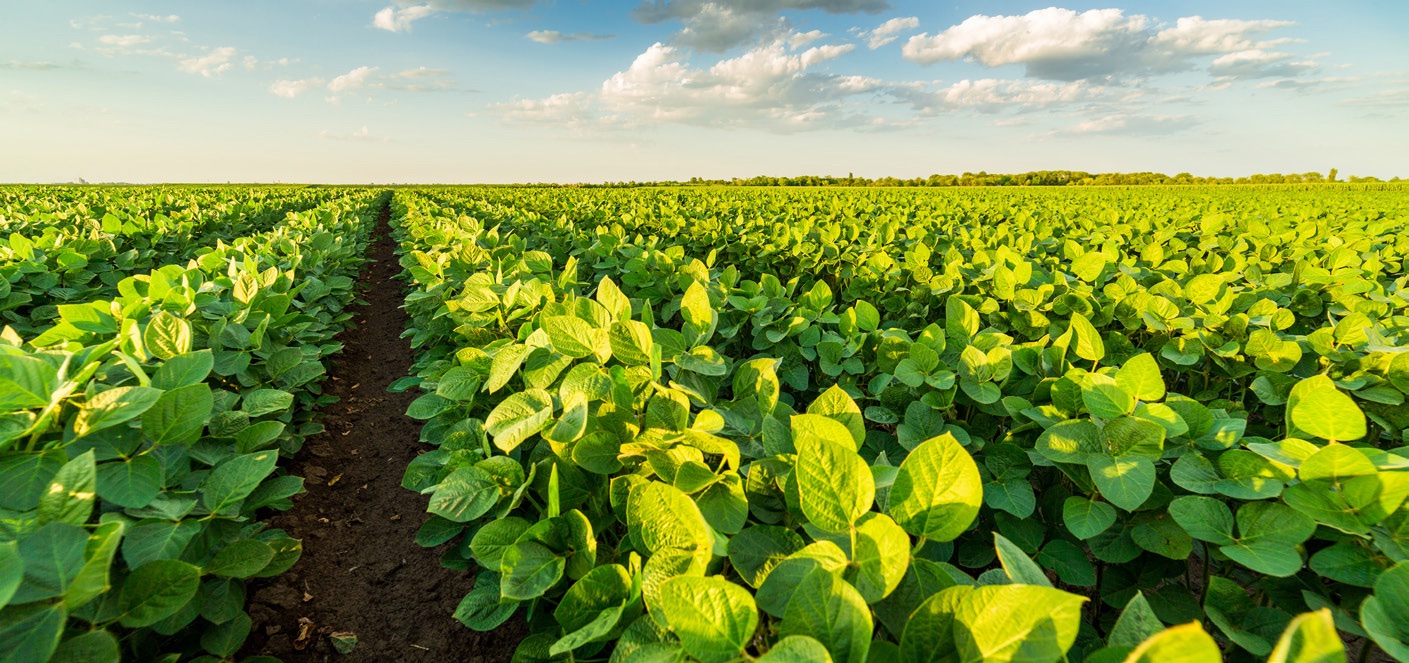KEY CONCEPTS
•
Today’s biobased base stock has overcome many of the issues of earlier generations, such as poor oxidative stability.
•
The price, once a major obstacle, also has come down.
•
While the market for these base stocks could still be considered niche, it is expanding—the market is expected to grow 8% annually.
Biobased base stock, which falls under the broader category of renewable base stock, is manufactured from biological material, usually, but not always plants. While it is renewable, it is not necessarily biodegradable—the two terms are not interchangeable.
Biobased base stock has been around for more than 30 years. However, its early iterations had many shortcomings and limited use as a result. These oils were marked by poor performance, especially in terms of oxidative stability and poor low temperature fluidity. But they always have possessed some natural advantages such as biodegradability, low toxicity, high viscosity index and low volatility. One improvement has come with the development of hybridized and genetically modified plant oils that have much higher levels of monounsaturation and very low levels of polyunsaturation. Another improvement is a groundbreaking class of biobased synthetic materials called estolides (
see Figure 1).
1 They are made from organic fatty acids found in bio-derived oils.
 Figure 1. The estolide development process. Figure courtesy of Biosynthetic Technologies.
Figure 1. The estolide development process. Figure courtesy of Biosynthetic Technologies.
Today’s advanced biobased oils have eliminated many of the shortcomings, with performance that is equal to or better than current Groups III and IV base oils, and opened this base stock to a much wider (although still niche) market. Equally as important, today’s oils also are cost-competitive with current conventional refined oils in specific applications.
A new class of ester molecules, called estolides, has been commercialized for biobased synthetic oils that performs as well as or better than conventional fossil and synthetic lubricant stock. Estolide base stocks are derived from oleochemicals, predominantly free fatty acids from oils sources like high oleic soy oil and castor oil. Life Cycle Assessments (LCA) of castor-derived estolides have been completed and found the molecules to be sustainable both from an environmental standpoint in terms of CO
2, NOx, SOx, TDS, other key environmental impacts and a social capacity as well. LCAs performed on estolides have shown that they offer an 83% to 88% reduction in greenhouse gas emissions as compared to similar petroleum-based synthetic oils, and one castor-derived estolide facility actually operates with a negative carbon footprint.”
One facility has been able to show, when accounting for the CO
2 uptake of the entire castor plant, their products leave the gate of the manufacturing facility in a carbon-negative state.
What makes a base stock biobased and/or renewable?
The terms biobased, renewable, recyclable, biodegradable and environmentally non-toxic are often used interchangeably, but they shouldn’t be. While there is some overlap, in most instances, they mean different things.
Biobased. The term “biobased” was introduced by the USDA to promote renewable plant-based (mostly crop-based) products. It’s a simple, straightforward definition. Most biobased base oils are biodegradable, but when formulated with chemical additives, they might no longer fit the definition of biodegradable—i.e., microorganisms cannot completely break them down into CO
2.
Renewable. A renewable base stock is a product that is made from plants or other regenerating materials and/ or a product that can be restored to its original state. The term renewable encompasses both biobased and recycled base stock. Biobased base stock might or might not be recyclable (or be capable of being recycled).
Recyclable. Base stock that is recyclable has the capability of being restored to its original state after use; it often applies to solid materials. Once the contaminants are removed, this base stock is then sold to blenders. Recycled base stock is subject to the same tests and standards as the original base stock. Another term for this is “re-refined” and often applies to liquid used petroleum oils.
Biodegradable. Biodegradable lubricants are those that meet specified standards for biodegradability. They can originate from any source—even petroleum that is non-renewable and unrecyclable. An oil such as PAO can be biodegradable, but since it is derived from mineral oil, it is not considered biobased (
see Figures 2 and 3). While a biobased oil is renewable and probably would be biodegradable, it is not necessarily biodegradable.
 Figure 2. Varnish formation in conventional motor oil versus estolide motor oil. Figure courtesy of Biosynthetic Technologies.
Figure 2. Varnish formation in conventional motor oil versus estolide motor oil. Figure courtesy of Biosynthetic Technologies.

Figure 3. Engine cleanliness—mineral-based versus biosynthetic-based oil. Figure courtesy of Biosynthetic Technologies.
Base stock that is biodegradable can be reduced into its common elements and returned back into the environment naturally. However, just because it is assimilated back into the environment doesn’t mean it won’t harm the environment—with enough time, nearly everything will biodegrade. Hence, biodegradable is not the same thing as environmentally non-toxic.
Environmentally non-toxic. There are a few definitions of the word “toxic”—from lethal to mildly debilitating. So, formulations that are sold as non-toxic to plants and animals might still be harmful by some definitions. Standard tests for environmental toxicity mostly apply to the marine environment. The most common tests are for acute toxicity, which measures the concentration required to kill organisms within a specific time period.
STLE Fellow Jack Zakarian, principal of JAZTech Consulting, LLC, explains, “Lubricants have several ways of being renewed. One is by cleanup of the existing lubricant, either by filtration and dehydration, or by a more complete re-refining process. Lubricants derived from petroleum can be considered renewable if they are reprocessed for reuse. Another way to qualify as renewable is by being made from biomass, such as plants, forest material and marine organisms.”
According to Zakarian, there are no internationally recognized definitions for the many ways a lubricant can be labeled (i.e., “environmentally friendly,” “environmentally acceptable,” “green” or “sustainable”).
“Europe has been a leader in setting standards for more environmentally acceptable products with the development of the Ecolabel program,” he says. “This program has a number of strict requirements relating to the environmental and health impacts of both blend components and the finished lubricant. There are tests for biodegradability, bioaccumulation and aquatic toxicity. There also are minimum requirements for the amount of renewable raw materials allowed in the lubricant.”
Zakarian believes that the USDA BioPreferred label is a good start for encouraging the use of lubricants (and other products) derived from biomass (
see USDA BioPreferred® Program). The major USDA technical requirements include:
1.
Determination of the percent bio-based content
2.
Minimum level of biobased carbon in a particular product.

USDA BioPreferred® Program3
The objective of the USDA BioPreferred Program, created in 2002 and expanded in 2018, is to promote the use of biobased products, including base stock—opening up new markets for agricultural products. Other benefits include reducing the dependence on petroleum and reducing the impact on the environment. The two primary aspects of the program are:
•
Purchasing mandates for federal entities and contractors. The USDA has created 139 product categories that have biobased purchasing requirements. Each category specifies the minimum requirement for biobased substance.
•
A biobased products labeling initiative. The USDA “Certified Biobased Product” label provides relevant information on the product’s biobased content.
An organization with a biobased offering that meets USDA requirements can include the USDA Certified Biobased Product label. While the program does apply to lubricants, it does not apply to fuels.
“The biobased content is measured according to ASTM D6866, which is a radioisotope method to compare the amount of ‘new’ carbon to ‘old’ carbon in a product,” he explains. “The minimum amount of biocontent can range from 25% for products such as engine oils up to 95% for transformer oils. The USDA program is much easier to meet compared with the Ecolabel program because there are no requirements for biodegradability, bioaccumulation, aquatic toxicity and chemical composition.”
Advancements in biobased oils
Environmental Lubricants Manufacturing, Inc. president Dr. Lou A. Honary has been involved in the development of biobased oils since 1991 as both an academic researcher and a manufacturing company principal. Under the guidance of Honary, the University of Northern Iowa’s National Ag-Based Lubricants Center (UNI-NABL) was a leader in the commercialization—for both industrial and consumer applications—of biobased lubricants and greases derived from plant and vegetable products.
“Since the early days, vegetable oils have presented superior performance in certain properties such as lubricity and viscosity index,” he explains. “But, in untreated vegetable oils, a lack of oxidation stability and higher pour point were the most notable barriers to their commercial success. With genetic enhancement of oilseed, chemical modification, mixing with more oxidatively stable oils and use of performance-enhancing chemicals, many of the barriers have been removed.
Dr. Matthew Kriech, chief operating officer of Biosynthetic Technologies, says that bio-derived base stocks compare favorably with Group III, IV and V base oils. “Our extensive testing demonstrates estolides are superior from a performance perspective. Estolides have superior solubility, viscosity index, lubricity, wear protection, toxicity and biodegradability.”
Some companies have built a portfolio of biobased/biodegradable base oils primarily via esterification. The biobased derived synthetic esters can be designed to offer a wide range of viscosities with superior oxidation stability and cold temperature flowability.
Feedstock and sustainability
One of the issues with the first generations of biobased feedstock was the lack of sustainability in terms of an uninterruptable source of plant material. While there was disagreement on this, some experts said there was actually not enough tillable land in the U.S. to yield enough soybeans to meet the market for lubricants and biofuels. For example, one acre of land can only produce 47 gallons of soybean oil annually, which will lubricate a single piece of heavy machinery for half a year. In order to meet the demand for plant-based fuels and lubricants in the U.S. alone, 612 million acres would have to be cultivated with soybeans. The problem is, only a grand total of 470 million acres of land in the U.S. can currently be farmed.
2
The logistics of supply and demand for these plant sources (as both feedstock and food) just didn’t make sense. However, most of the feedstock 20 years ago was going toward producing high volume biofuels. Today, it is going toward lubricants.
The conclusion was that the products are non-GMO, don’t compete with food crops, don’t require habitat alteration or destruction of rainforests and are in a carbon-negative state prior to shipment from the production facilities.
The market
As renewable base stocks become more accepted in mainstream applications, niche markets continue to develop. Markets where renewable base stock is currently delivering significant value include applications that are in, or adjacent to, aquatic areas and forests and where workers have the potential to be exposed to industrial fluids.
Kriech says, “Generally, anywhere you can utilize a Group III, IV or V base oil, you can use an estolide as well.”
“There definitely is an increasing interest in biobased lubricants and a healthy growth rate,” Zakarian says. “A major reason is that biobased products can help limit the global buildup of CO
2. They also offer other advantages such as biodegradability.”
Honary summarizes, “We are finally beginning to see a global market pull for our products, especially in shipping, railroads and mining areas. We believe that in time most greases used in mining, shipping, railroads and trucking will be biobased greases. We agree with many of the annual growth rate estimates seen in our industry of about 8%.”
REFERENCES
1.
Patented estolides are a result of the formation of a carbocation at the site of unsaturation that can undergo nucleophilic addition by another fatty acid, with or without carbocation migration along the length of the chain, to form an ester linkage. The secondary ester linkages of the estolide are more resistant to hydrolysis than those of triglycerides, and the unique structure of the estolide results in materials that have far superior physical properties for lubricant applications than traditional vegetable and mineral oils. From
here.
2.
Ing, A. (2009),
Biobased Lubricants: A Viability Study. Available
here.
3.
From “What is BioPreferred?” Available
here.